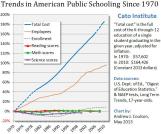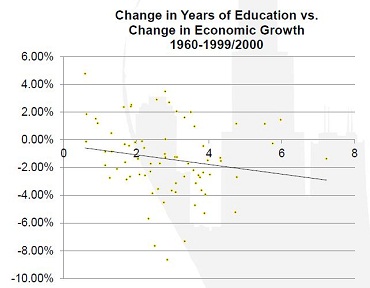I’ve written several times about how dumping more money into government schools is not a recipe for improved education.
 Indeed, I would argue that this chart is the most powerful image I’ve ever seen. More and more money gets plowed into the system (even after adjusting for inflation!), but the only effect is that school systems hired more bureaucrats.
Indeed, I would argue that this chart is the most powerful image I’ve ever seen. More and more money gets plowed into the system (even after adjusting for inflation!), but the only effect is that school systems hired more bureaucrats.
There hasn’t been any positive impact on student test scores.
It’s especially depressing when you compare the United States with other developed nations. We spend more than other countries, on a per-student basis, yet our test scores are below average.
Politicians periodically admit there is a problem, but their solutions – such as Bush’s no-bureaucrat-left-behind scheme and Obama’s common-core boondoggle– simply squander money and rearrange the deck chairs on the Titanic.
Let’s examine whether this pattern is true in other nations. I already shared some research showing that big spending increases in Indonesia didn’t have a positive impact.
Now let’s look at multi-country analysis. We’ll start by looking at a study by a scholar from the World Bank and Harvard’s Kennedy School.
Cross national data show no association between the increases in human capital attributable to rising educational attainment of the labor force and the rate of growth of output per worker. This implies the association of educational capital growth with conventional measures of TFP is large,
strongly statistically significant, and negative. …Three causes could explain why the impact of education varied widely across countries and fell short of what was hoped. First, the institutional/governance environment could have been sufficiently perverse that the educational capital accumulation lowered economic growth. Second, perhaps the marginal returns to education fell rapidly as the supply expanded while demand for educated labor was stagnant. Third, educational quality could have been so low that “years of schooling” have created no human capital.
Here’s some statistical analysis from Professor Garett Jones of George Mason University.
Between the 60’s and the 90’s every country in this sample boosted its average years of education–it was a golden age of alleged human capital investment. Some nations boosted schooling more, some less.
How did that turn out? …The trendline points down slightly, but for the time being let’s just call it a draw. It’s a well-known fact that countries that started the 1960’s with high education levels grew faster…, but this graph is about something different. This graph shows that countries that increased their education levels did not grow faster.
And here’s his graph.

This data clearly shows that dumping more money into education doesn’t work.
So perhaps the problem is the way the money is getting spent, not the amount.
That’s why the moral of the story is that we need to break up government school monopolies and harness the power of the market by giving parents and students genuine school choice. For what it’s worth, there’s strong evidence that choice produces good outcomes in the limited instances where it is allowed in the United States.
P.S. There’s also strong evidence for school choice from nations such as Sweden, Chile, and the Netherlands.
P.P.S. Needless to say, eliminating the Department of Education is part of the solution.

